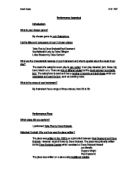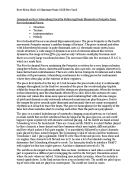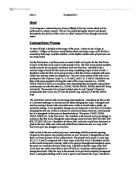Identify ONE teaching and learning issue, with a curriculum focus, which has been of significance to you in you induction year. Discuss this issue drawing upon the relevant academic and professional literature and your induction experiences to support you
CONTENTS Assignment # Appendix I - Example questions from the MidYIS Test # Appendix II - Example questions from the Arnold Bentley Test # Bibliography # ASSIGNMENT: Identify ONE teaching and learning issue, with a curriculum focus, which has been of significance to you in you induction year. Discuss this issue drawing upon the relevant academic and professional literature and your induction experiences to support your discussion. (5000 words) INTRODUCTION This essay is an exploration into the relevance of MidYIS tests as a predictor for results at GCSE Music. A comparison will be made between two sets of skills: those assessed by the MidYIS test - taken by most children in England at the beginning of year 9 - and those which, according to exam boards and experienced music educators, are tested at GCSE. Certain fundamental skills required for success at GCSE Music cannot be tested in the MidYIS tests, and I would suggest that a combination of MidYIS-type testing, musical intelligence assessment and some measure of the amount and quality of musical experience gained before embarking on the GCSE course would serve as a much more relevant indicator of likely success, and a more appropriate baseline from which to measure value added. However, the term 'success' needs defining - many pupils who are excellent musicians even before they reach year 9 may not obtain the
A Brief History of the Blues
A Brief History of the Blues Joseph Machlis says that the blues is a Native American musical and verse form, with no direct European and African antecedents of which we know. In other words, it is a blending of both traditions. The word 'blue' has been associated with the idea of melancholia or depression since the Elizabethan era. The American writer, Washington Irving is credited with coining the term 'the blues,' as it is now defined, in 1807. The earlier (almost entirely Negro) history of the blues musical tradition is traced through oral tradition as far back as the 1860s. When African and European music first began to merge to create what eventually became the blues, the slaves sang songs filled with words telling of their extreme suffering and privation. One of the many responses to their oppressive environment resulted in the field holler. The field holler gave rise to the spiritual, and the blues, "notable among all human works of art for their profound despair. They gave voice to the mood of alienation and anomie that prevailed in the construction camps of the South." It was in the Mississippi Delta that blacks were often forcibly conscripted to work on the levee and land-clearing crews, where they were often abused and then tossed aside or worked to death. Alan Lomax states that the blues tradition was considered to be a masculine discipline (although some of
My chosen genre is Jazz Saxophone.
Performance Appraisal Introduction What is your chosen genre? My chosen genre is Jazz Saxophone. List the titles and composers of your 3 chosen pieces Take Five by Dave Brubeck/Paul Desmond Sophisticated Lady by Duke Ellington Lotus Blossom by Dave Sanborn What are the characteristic features of your instrument and what is special about the music it can play? The music the saxophone can play is very varied. It can play classical, jazz, blues, big band, March e.t.c. There are lots of different styles but the most common is probably jazz. The saxophone is used as it has a number of sounds and techniques which are associated and used for jazz, such as bending notes. What is the range of your instrument? My instrument has a range of three octaves, from Bb to Bb: Performance Piece Which piece did you perform? I performed Take Five by Dave Brubeck. Historical Context: Why and how was the piece written? The piece was written in the 1960's as a joint effort between Paul Desmond and Dave Brubeck. However, most of it was by Dave Brubeck. The piece was primarily written for the Dave Brubeck Quartet which consisted of: Dave Brubeck himself Joe Morello Eugene Wright Paul Desmond The piece was written on a stave using traditional notation. What is the style of the piece? The style of the piece is bluesy/jazzy and swung. What are the main features of the style? The
Indian Instruments
Main Indian Instruments Tala The rhythmic system of classical Indian music, which governs compositions and much of the improvised material of a performance. The word itself does not simply mean rhythm, but signifies instead a beating or clapping of time. Put in its simplest way, a Tala is a repeating cycle of a number of beats, grouped in a particular way. The concept applies to both the Hindustani (northern) and Carnatic (southern) traditions of Indian music, although there are important differences in the names, organizations, and usages of the talas, and in Carnatic music a greater variety is employed. In Hindustani music, by far the commonest Tala is the one known as Tintal, so it can also be described as the commonest of all Indian talas, and is therefore ideal to exemplify the principles of Tala. Tintal has an avarta or avritti (cycle) of 16 matras (units, beats), grouped into 4 vibhags of 4 matras. To ensure that the cycle repeats only after 16 beats, rather than after every 4 beats, 1 vibhag (in this Tala the 3rd one) is distinguished from the others, and is known as the khali, which means empty. When the Tala is indicated by hand-claps, the 1st matra of each vibhag is marked by a clap, but the 1st matra of the khalivibhag (the 9th matra in Tintal) is marked by a wave, and, in notations, by a zero. The other 3 vibhags are marked on their 1st matra (the 1st, 5th and
American Society In the 1920’s
American Society In the 1920's After the First World War, America became very wealthy due to the large sums of money they had loaned to other countries during the war. Not only did the countries repay the loans; they were forced to pay interest. This meant America did very well out of the war unlike most of the other countries that were in debt and their economies were struggling. With the extra money America was gaining, people could afford to indulge themselves, people went out more, and they didn't want to stay indoors all the time. Housewives discovered a whole new world away from cooking and cleaning, with the new technology chores took less time, women could use dishwashers, washing machines and tumble dryers which gave them time to go out and entertain themselves. With the increasing demand for entertainment the profile of cinema, music and sport soon changed. America suddenly became modern, some people disapproved of this, they were outraged to see short skirts on women in films, and they thought it was setting a bad example for America but this was only the beginning. In the 1920's, when good electronic amplifiers became available cinema changed from being completely silent to having sound, these were nicknamed the talkies. The first well known 'talkie' was The Jazz singer (1927) produced by the four Warner Brothers, since then all the audience wanted to hear was
Hydens Trumpet Concerto and Aranjez Analysis
Classical Music Written By: Trish Allan Music is the emotional response between time and space. Throughout the ages, music has developed many different forms from various different eras. These eras show what was popular at the time and particular musical elements help us to categorize what pieces and composers go into which era. The Classical Period was from 1720-1820. Although it only lasted 70 years, it made long lasting impressions on the orchestra that we still see today. As well as the Classical Period, there was the Neo-Classical Period, which, after a number of years, brought back the Classical age with some added elements. Which leads to say; which is more classical? There are two pieces analyzed in this text. Haydn's Trumpet Concerto composed by Joseph Haydn in the Classical period and Concerto De Aranjuez composed by Joaquin Rodrigo in the late Neo-Classical period. Joseph Haydn composed his first and last trumpet concerto in 1796 in Vienna after his second return from England. It was particularly composed because of the development of the new valve trumpet. When the valve trumpet was developed, Haydn wanted to explore the wider tonal range of this newly developed instrument. And in doing so, he created his only Trumpet Concerto, known today as Haydn's Trumpet Concerto. Written in three movements, Allegro I, Andante II and Allegro III, the most popular and famous
Biography of Wolfgang Mozart.
Biography of Wolfgang Mozart WOLFGANG GOTTLIEB MOZART, one of the greatest of musical composers, was born January 27th 1756, at Salzburg, where his father was sub-director of the Archepiscopal Chapel. His extraordinary musical talents were cultivated to the utmost by his father. At the age of four he played the clavichord, and composed a number of minuets and other pieces still extant. When only six years of age, his performances were so remarkable, that his father took him and his sister, who possessed similar gifts, to Munich and Vienna, where they obtained every kind of encouragement from the Elector of Bavaria, and the Emperor Francis I. In 1763 and 1764, the Mozart family visited Paris and London. At the age of seven, young Mozart surprised a party of musicians, including his father, by taking part, at sight, in a trio for stringed instruments. Symphonies of his own composition were produced at a public concert in London; and while there he composed and published six sonatas, and made acquaintance with the works of Handel, recently deceased. Two years later, when but twelve years of age, he composed the music for the religious service, and for a trumpet concert at the dedication of the Orphan House Church, in Vienna, and conducted it in the presence of the imperial court, in 1769, at the age of thirteen, he was appointed director of the Prince Archbishop of Salzburg's
Sound Sources
Samplers This is an electronic musical sampler, it's called an Akai MPC 2000; a type of sampler. This is closely related to a synthesizer but it generates sounds from scratch instead of putting sounds through the device. However they usually use sample sounds then plays it back on how it is configured. Nowadays there are much more updated ones; there are different ones with great technology as where you can put sample CD's in it. Now you can get software samplers which are inside the programme itself and you can do the exactly the same as if you had it externally. The beauty of samplers is that you can either create your own drum kit or you can sample different songs to make a remix, this may not be making your own music but you can gain fun out of it. Synthesizers This is a Roland synthesizer it is an electronic musical instrument, there are different types of synthesizers for example there's one for vocals and another for instruments. Synthesizers change the type of sound that is put through the machine; artist such as t-pain to change the effect of the voice. They also use instrument synthesizers to change the sound of the instrument. Nowadays they have virtual synthesizers on music software's such as Cubase, Fruity Loops, Reason and many more. Nowadays most people use synths inside the DAW (digital audio workstation) they produce a lot of different sounds also you can
Music Publishing
Music Publishing In this assignment we are going to take a closer look at music publishing, the working patterns withing this area and the function music publishing has. First we will take a closer look at one specific publishing company: Universal Music Publishing Group (UMPG). UMPG is the largest publishing company in the world and has offices all around the world from North America to Australasia. It is the world's largest Classical music publisher, and through its ownership of Brentwood-Benson Music Publishing it owns the world's largest Christian music publishing catalogue as well as being a global leader in Production music. UMPG stands strong in the Film and TV & Advertising area as well. By using a centralized global administrative model and a computer system that can quickly and accurately track and register songs, UMPG sees too that money collections are made fast and paid from collection societies, so that its clients can recieve the best service possible. Some of the songs on the UMPG list are 'Sexyback' by Justin Timberlake, 'Stayin Alive' by The Bee Gees, 'Irreplaceable' by Beyoncé, 'Beautiful Day' by U2, 'Be Without You' by Mary J. Blige, 'You're Beautiful' by James Blunt and many more. Other artists include Coldplay, Bon Jovi, Kirk Franklin, Micheal W. Smith, Elton John, Joss Stone, Paul Simon, Robbie Williams, Westlife and many more. In film and TV UMPG
BTEC First Certificate in Music - UNIT 9 (Audio Recording/Mixing Desk)
Unit 9 For this assignment in the BTEC First Certificate in Music was to produce a completed mix of a multi-track music recording. The song had to have a maximum of 16 tracks and consist of audio recordings only with the exception of a piano track being sequenced. In my group there was: myself, Gregory and Mario. The song we all decided to cover was 'Teach Me' by Musiq Soulchild. In our cover the song was made up of five parts: the drums, lead guitar, bass guitar, piano and vocals. For this assignment we could only use Logic Pro to record the tracks however not mix, automate or use effects from within the application. We had to use reverb and compression appropriately when you mix, as well as careful use of panning and level selection for balance. For this assignment I used computer-based music creation systems. For recording the drum tracks and the vocal tracks we used was a Dual-Core Intel Mac Pro (Fig.1) running Mac OS X 10.4. The software used was Logic Pro 8. The mixing desk used was the Soundcraftt Ghost 16 and the soundcard was MOTU 828 MkII Firewire interface (Fig.2). For recording the bass track, guitar track and piano track we used an Intel iMac with a 2.0 GHz Core 2 Duo processor and 1GB RAM running Mac OS X 10.4 The keyboard was a Roland XP-10 MIDI keyboard (Fig.3) connected to the iMac via: two five pin DIN cables which were plugged into an Edirol UA-25 USB



























